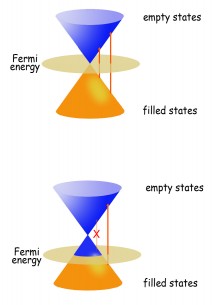
Scientists at the U.S. Department of Energy’s Lawrence Berkeley National Laboratory (Berkeley Lab) and the University of California at Berkeley have learned to control the quantum pathways determining how light scatters in graphene.
Controlled scattering provides a new tool for the study of this unique material – graphene is a single sheet of carbon just one atom thick – and may point to practical applications for controlling light and electronic states in graphene nanodevices.
The research team, led by Feng Wang of Berkeley Lab’s Materials Sciences Division, made the first direct observation, in graphene, of so-called quantum interference in Raman scattering. Raman scattering is a form of “inelastic” light scattering. Unlike elastic scattering, in which the scattered light has the same color (the same energy) as the incident light, inelastically scattered light either loses energy or gains it.
Raman scattering occurs in graphene and other crystals when an incoming photon, a particle of light, excites an electron, which in turn generates a phonon together with a lower-energy photon. Phonons are vibrations of the crystal lattice, which are also treated as particles by quantum mechanics.
Quantum particles are as much waves as particles, so they can interfere with one another and even with themselves. The researchers showed that light emission can be controlled by controlling these interference pathways. They present their results in a forthcoming issue of the journalNature, now available in Advance Online Publication.
Manipulating quantum interference, in life and in the lab
“A familiar example of quantum interference in everyday life is antireflective coating on eyeglasses,” says Wang, who is also an assistant professor of physics at UC Berkeley. “A photon can follow two pathways, scattering from the coating or from the glass. Because of its quantum nature it actually follows both, and the coating is designed so that the two pathways interfere with each other and cancel light that would otherwise cause reflection.”
Wang adds, “The hallmark of quantum mechanics is that if different paths are nondistinguishable, they must always interfere with each other. We can manipulate the interference among the quantum pathways that are responsible for Raman scattering in graphene because of graphene’s peculiar electronic structure.”
In Raman scattering, the quantum pathways are electronic excitations, which are optically stimulated by the incoming photons. These excitations can only happen when the initial electronic state is filled (by a charged particle such as an electron), and the final electronic state is empty.
Quantum mechanics describes electrons filling a material’s available electronic states much as water fills the space in a glass: the “water surface” is called the Fermi level. All the electronic states below it are filled and all the states above it are empty. The filled states can be reduced by “doping” the material in order to shift the Fermi energy lower. As the Fermi energy is lowered, the electronic states just above it are removed, and the excitation pathways originating from these states are also removed.
“We were able to control the excitation pathways in graphene by electrostatically doping it – applying voltage to drive down the Fermi energy and eliminate selected states,” Wang says. “An amazing thing about graphene is that its Fermi energy can be shifted by orders of magnitude larger than conventional materials. This is ultimately due to graphene’s two-dimensionality and its unusual electronic bands.”
The Fermi energy of undoped graphene is located at a single point, where its electronically filled bands, graphically represented as an upward-pointing cone, meet its electronically empty bands, represented as a downward-pointing cone. To move the Fermi energy appreciably requires a strong electric field.
Team member Rachel Segalman, an associate professor of chemical engineering at UC Berkeley and a faculty scientist in Berkeley Lab’s Materials Sciences Division, provided the ion gel that was key to the experimental device. An ion gel confines a strongly conducting liquid in a polymer matrix. The gel was laid over a flake of graphene, grown on copper and transferred onto an insulating substrate. The charge in the graphene was adjusted by the gate voltage on the ion gel.
“So by cranking up the voltage we lowered the graphene’s Fermi energy, sequentially getting rid of the higher energy electrons,” says Wang. Eliminating electrons, from the highest energies on down, effectively eliminated the pathways that, when impinged upon by incoming photons, could absorb them and then emit Raman-scattered photons.
What comes of interference, constructive and destructive
“People have always known that quantum interference is important in Raman scattering, but it’s been hard to see,” says Wang. “Here it’s really easy to see the contribution of each state.”
Removing quantum pathways one by one alters the ways they can interfere. The changes are visible in the Raman-scattering intensity emitted by the experimental device when it was illuminated by a beam of near-infrared laser light. Although the glow from scattering is much fainter than the near-infrared excitation, changes in its brightness can be measured precisely.
“In classical physics, you’d expect to see the scattered light get dimmer as you remove excitation pathways,” says Wang, but the results of the experimenter came as a surprise to everyone. “Instead the signal got stronger!”
The scattered light grew brighter as the excitation pathways were reduced – what Wang calls “a canonical signature of destructive quantum interference.”
Why “destructively?” Because phonons and scattered photons can be excited by many different, nondistinguishable pathways that interfere with one another, blocking one path can either decrease or increase the light from scattering, depending on whether that pathway was interfering constructively or destructively with the others. In graphene, the lower and higher-energy pathways interfered destructively. Removing one of them thus increased the brightness of the emission.
“What we’ve demonstrated is the quantum-interference nature of Raman scattering,” Wang says. “It was always there, but it was so hard to see that it was often overlooked.”
In a second observation, the researchers found yet another unexpected example of inelastic light scattering. This one, “hot electron luminescence,” didn’t result from blocked quantum pathways, however.
When a strong voltage is applied and the graphene’s Fermi energy is lowered, higher-energy electron states are emptied from the filled band. Electrons that are highly excited by incoming photons, enough to jump to the unfilled band, thus find additional chances to fall back to the now-vacant states in what was the filled band. But these “hot” electrons can only fall back if they emit a photon of the right frequency. The hot electron luminescence observed by the researchers has an integrated intensity a hundred times stronger than the Raman scattering.
The road taken
The poet Robert Frost wrote of coming upon two roads that diverged in a wood, and was sorry he could not travel both. Not only can quantum processes take both roads at once, they can interfere with themselves in doing so.
The research team, working at UC Berkeley and at Berkeley Lab’s Advanced Light Source, has shown that inelastic light scattering can be controlled by controlling interference between the intermediate states between photon absorption and emission. Manipulating that interference has enabled new kinds of quantum control of chemical reactions, as well as of “spintronic” states, in which not charge but the quantum spins of electrons are affected. Strongly enhanced Raman scattering can be a boon to nanoscale materials research. Hot luminescence is potentially attractive for optoelectronics and biological research, in which near-infrared tags – even weak ones – could be very useful.
“Likewise the phenomenon of hot electron luminescence, because it immediately follows excitation by a probe laser, could become a valuable research tool,” says Wang, “particularly for studying ultrafast electron dynamics, one of the chief unusual characteristics of graphene.”



